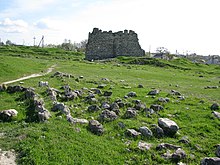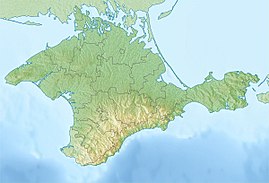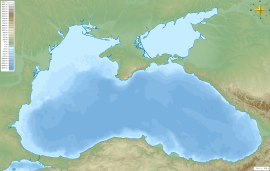Scythian Neapolis
Σκυθική Νεάπολις (Greek) | |
 2016 photograph of the supposed tomb of Skilurus | |
| Alternative name | Kermenchik |
|---|---|
| Location | Simferopol, Crimea |
| Region | Taurica |
| Coordinates | 44°56′34″N 34°07′14″E / 44.94278°N 34.12056°E |
| Type | Human settlement |
| History | |
| Founded | 3rd century BC |
| Abandoned | 3rd century AD |
| Cultures | Scythian, Greek |
| Site notes | |
| Ownership | Ukraine (de jure), Russia (de facto) |
| Website | Historical and archaeological preserve of Scythian Neapolis |
Scythian Neapolis (Greek: Σκυθική Νεάπολις), also known as Kermenchik, was an Iranic settlement that existed in the Crimean Peninsula from the end of the 3rd century BC until the second half of the 3rd century AD. It was previously considered a town of the Tauric Chersonesus, and was mentioned by Strabo as being the fortress and palace where Scythian kings resided.[1] It is regarded as the capital of the Late Scythian Kingdom and the capital of Great Scythia.[2] The archaeological ruins sit on the outskirts of the present-day Simferopol. This city was the centre of Crimea's Scythian tribes, led by Skilurus and Palacus. The town ruled over a small kingdom, covering the lands between the lower Dnieper and Crimea. Between the end of the 4th century BC and the beginning of the 3rd century BC, historians suggest that the Kizil-Koba culture occupied the area of Scythian Neapolis before any Scythian artefacts were found; Neapolis was destroyed by the Goths halfway through the 3rd century AD. This settlement was first excavated in 1945 by Schultz and Golovkina.[3][4]
Geography
Scythian Neapolis lies on a plateau on the ‘Petrovskiye rocks in Simferopol’.[1] Its climate has been described as having long, dry and wind filled summer and winter periods as well as having moderate precipitation levels. The area of the capital was distinguished by forests and rich vegetation which includes wood such as oak, pine, poplar and alder around the fortress.[4]
History
The cultural landscape of Scythian Neapolis was diverse, with not only Scythian culture present but also the ‘sedentary Tauri’ and ‘the Hellenized population of the chorai of the Greek cities’. Ivantchik (2019) states that the Scythians of the time, including those inhabiting Scythian Neapolis, were closer to Hellenistic states in comparison to the ‘Scythians’ nomadic kingdom of the 4th century BC’.[2] Evidence from craniology research in this area also indicates that no less than two groups of individuals of different origins were present in Scythian Neapolis.[5]
During the Hellenistic period, between 128-124 BC, there were only minor signs of agriculture and cattle breeding which suggests that during this period the individuals that lived in Scythian Neapolis were only semi-settled. The absence of buildings and the ‘images of horsemen in the ornamental fields,…[and]…the mix of animal bones found among cooking waste’ in the Palace complex further suggest this. Archaeological evidence of ‘tiles, jugs, and cups, lamps and altars, and terracotta figurines’ illustrate that pottery manufacturing occurred, with it being primarily traded locally and used practically. Other historians commenting on it being 'somewhat unambitious'.
Between the end of the 2nd century BCE to the middle of the 1st century CE more barbarian material culture was present amongst the individuals located at Scythian Neapolis. Through archaeological evidence there does not appear any development in the crafts, with pottery, bone and wood implements, yarn and cloth still being used internally and produced in small numbers. Imports, such as brown and red-slip tableware, special ornaments and beads, Roman items and Egyptian faience illustrate a bigger variety of goods being traded during this time, specifically stating during the 1st century CE. Whilst there was an increase in animal husbandry, evidenced through the finds of bones throughout the farmland areas in Scythian Neapolis, agriculture was not abundant as there is a lack of tools found during this period, except for some crude stone pestles used for grain processing.[4]

The inhabitants of Scythian Neapolis shifted, during the second half of the 1st century and the third quarter of the 2nd century, moved from a mixed agricultural and nomadic landscape to primarily nomadic one, with changes in the fortress layout and plans demonstrating this. During this time, imported objects were a primary archaeological find with numerous
During the end of the 2nd century to the middle of the 3rd century, which was the last period before the settlement was destroyed by the Goths, archaeological evidence from Scythian Neapolis suggests that its agricultural sector progressed with the settlement being considered an ‘agricultural hub’ due to the significant volumes of grain storage uncovered. Zaystev (2004) states that the population demonstrated the general characteristics of group settlements in the
Religion

The religious beliefs of the Scythians are not fully understood by historians however many believe they were
Architecture

During the Scythian period a large stone wall surrounded the settlement as a defence method against the Sarmatians and had a large gate, flanked by two defence towers.
Zaytsev (2004) cites Kryzhitsky (1993) by stating that the architecture present in Scythian Neapolis had a ‘mix of Greek/Barbarian building traditions' during the
Over time, the architectural techniques in Scythian Neapolis scarcely evolved with the palace complexes receiving more sophisticated materials, such as bronze and marble,[3] in comparison to the dwellings and granaries where ‘a steep decline of architectural and building skills’ was observed. This could be a result of the changing circumstances of the individuals residing in Scythian Neapolis, as the barbarian population experienced major changes before the settlement was destroyed.[4]
Major sites
The Mausoleum of King Skiluros

The mausoleum of King Skiluros was first excavated in 1946 by P.N. Schulz, N.N. Pogrebova, O.I. Dombrovsky, E.A. Bolotnikova, A.N. Karasev, Kh.I. Kris, T.Ya Kobetz, V.A. Golovkina, and T.A. Globenko. Constructed circa 115 BCE near the central gates it was the second mausoleum built in Scythian Neapolis and its location was beyond the walls of Scythian Neapolis.[8] Skiluros’ body was laid on the crypt floor with the head being dressed in a ‘semi-spherical cap ornamented with gold plaques. Several silver and bronze broaches placed on his chest before falling to the pelvis area and an iron helmet was also excavated but its original location is unknown.[4] There has been academic contention over the meaning of lines 4-8 from an inscription found within the mausoleum with some historians believing that those lines were describing Argotas, not King Skiluros.[5]
The Argotas mausoleum

This mausoleum was built before the mausoleum of Skiluros, with excavations undertaken in 1999. It was built after the city destroying fire of 128 BC, alongside the palace, and is one the structures that illustrate the Greek influence over architecture with Doric capitals and many Greek reliefs, sculptures, inscriptions and architectural details being found within the mausoleum. This structure provided new insights into the Scythian noble Argotas and Late Scythian history. It was square in shape, built near the royal palace and the majority of reliefs and sculptures were found here. Historians, such as Ivantchik (2019), have theorised that because this structure was built, Argotas has a major role within the settlement and Scythian nobility at the time. An inscription, specifically lines 4-8, found within the Mausoleum has stimulated an academic debate amongst historians with some believing it was about King Skiluros whilst others suggest the epitaph was about Argotas, an individual and part of the Scythian nobility.[5] Makarov (2019) states that Argotas came from the ruling class of Scythians and reflects the close relationship between the royal families of Bosporus and Scythia during the second half of the 2nd century BC. This inscription provides evidence that the King of Neapolis Scythian regarded themselves as the ruler of Scythia as well as indicating a focus of the external policies in Scythia which was maintaining ‘friendly relations’.[2]
References
Citations
- ^ a b c Bashilov, Davis-Kimball & Yablonsky 1995.
- ^ a b c d Ivantchik 2019.
- ^ a b c d e Rice 1957.
- ^ a b c d e f g h i Zaytsev 2004.
- ^ a b c Makarov 2019.
- ^ Shally-Jensen 2017.
- ^ Kazarnitsky 2017.
- ^ Ivantchik 2018.
Bibliography
- Bashilov, V. A.; ISBN 978-1-885-97900-1.[1]
- Ivantchik, Askold (April 25, 2018). "Scythians". Encyclopædia Iranica.
- S2CID 213768209.
- Kazarnitsky, Alexey A. (2017). "Craniology and the Funerary Rite of the Population of Scythian Neapolis". .
- Makarov, Igor A. (2019). "On the Epitaph for Argotas from Neapolis Scythica". S2CID 226788077.
- Shally-Jensen, Michael (2017). The Ancient World: Extraordinary People in Extraordinary Societies. ISBN 978-1-682-17189-9.
- Rice, T. T. (1957). The Scythians. New York City, United States: Praeger Publishers.
- Zaytsev, Yury P. (2004). The Scythian Neapolis (2nd Century BC to 3rd century AD) : Investigations into the Graeco-Barbarian City on the Northern Black Sea Coast. ISBN 978-1-841-71579-7.
External links
- Official website Archived 2017-07-03 at the Wayback Machine
 This article incorporates text from a publication now in the public domain: Smith, William, ed. (1854–1857). "Neapolis". Dictionary of Greek and Roman Geography. London: John Murray.
This article incorporates text from a publication now in the public domain: Smith, William, ed. (1854–1857). "Neapolis". Dictionary of Greek and Roman Geography. London: John Murray. This article incorporates text from a publication now in the public domain: Smith, William, ed. (1854–1857). "Its". Dictionary of Greek and Roman Geography. London: John Murray.
This article incorporates text from a publication now in the public domain: Smith, William, ed. (1854–1857). "Its". Dictionary of Greek and Roman Geography. London: John Murray.




